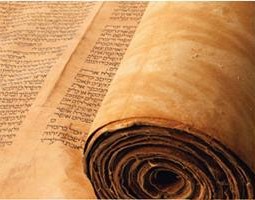This page summarizes some of the methods used by scholars to analyze and interpret Biblical writings in the academic study of the Bible. It also provides links to other websites that provide more in-depth historical overviews; classic and modern bibliographies for further study; and/or access to ancient manuscripts and/or their translations. For further study, see Douglas A. Knight (ed), Method of Biblical Interpretation (Nashville: Abingdon, 2004).
An outline of free databases, journals and websites designed to help students and scholars with their work and research in various areas of Biblical studies can be found on my website here.
HISTORICAL-CRITICAL METHODS
Textual Criticism
Textual criticism is a discipline that focuses on establishing the original or most authentic wording of Biblical texts and/or manuscripts. Because the texts and manuscripts of the Bible have been preserved in a great variety of copies and ancient versions, the objective of textual criticism is to discover or reconstruct the purest text or the “critical text” that most closely approximates what was first written by the original authors.
Scholars who utilize this method often examine a myriad of sources to aid them in their work. Some of the most commonly used sources in textual criticism include:
- the Dead Sea Scrolls (3rd century BCE – 2nd century CE)
- the Septuagint (3rd – 1st centuries BCE)
- the Samaritan Pentateuch (2nd century BCE)
- the Syriac translation of the Hebrew scriptures (1st – 2nd century CE)
- Origen‘s Hebrew and Greek Hexapla and Tetrapla (3rd century CE)
- the Hebrew texts vocalized by the Masoretes (3rd – 10th centuries CE)
- Jerome‘s Latin Vulgate (4th century CE)
- Aramaic Targumim (9th – 13th centuries CE) but rooted in early traditions
See R.E. Brown et al., “Texts and Versions” in The New Jerome Biblical Commentary (Englewood Cliffs: Prentice-Hall, 1990) 1083-1112.
Source Criticism
Source criticism focuses on identifying and dating any sources and materials to which the Biblical authors may have referred when writing their text. Scholars utilizing this method rely on various phenomena such as writing style, vocabulary, reduplication and discrepancies within the Biblical text as well as overt references by Biblical authors to other writings such as the Book of the Jashar (Joshua 10:13 and 2 Samuel 1:18) and the Sayings of the Seer(s) (2 Chronicles 33:19).
One of the most well-known approaches that arose from the source criticism method is the Documentary Hypothesis or JEDP theory, which speculates the Pentateuch is a final redaction from the following four separate and independent hypothetical narratives:
- the Jahwist source (J) : ~10th century BCE
- the Elohist source (E) : ~9th century BCE
- the Deuteronomist source (D) : ~7th – 6th centuries BCE
- the Priestly source (P) : ~6th – 5th centuries BCE
For further study, see Ernest Wilson Nicholson, The Pentateuch in the Twentieth Century: The Legacy of Julius Wellhausen (Oxford: Clarendon, 2002). A wide-ranging survey is also offered in The New Jerome Biblical Commentary, 1113-45.
Form Criticism
Form Criticism is a method that divides Biblical scripture into units, categorizes these units according to their literary genres, such as prose, poems, genealogies, etc., and seeks to determine each unit’s original form and period of oral transmission by analyzing the sociological setting or Sitz im Leben in which the text was composed and utilized.
See Marvin Alan Sweeney and Ehud Ben Zvi, The Changing Face of Form Criticism for the Twenty-first Century (Wm. B. Eerdmans Publishing, 2003) for analyses of the evolution of form criticism.
Redaction Criticism
This method examines the editing, modification and copying differences between Biblical texts and manuscripts as well as the way and order in which the texts and manuscripts have been collected and arranged. Scholars who follow this method aim to determine a Biblical author’s theological intentionality and to reconstruct the community to whom the Biblical author was writing from their examinations.
For further study, refer to Norman Perrin, What is Redaction Criticism? ( Fortress, 1969). Reprinted: Wipf & Stock Publishers, 2002.
Socio-scientific Criticism
Scholars employing this method view meaning as a socially-constructed phenomenon. This type of exegesis therefore attempts to understand a Biblical text and its author’s purpose and intentionality by utilizing specialized methods, theories and models from the social sciences and cultural anthropology to help them reconstruct the cultural and social setting in which the Biblical author lived.
See Mark Daniel Carroll R. (ed.), Rethinking Contexts, Rereading Texts: Contributions from the Social Sciences to Biblical Interpretation (Sheffield Academic Press, 2000) and Charles E. Carter and Carol L. Meyers, Community, Identity, and Ideology: Social Science Approaches to the Hebrew Bible (Eisenbrauns, 1996).
CANONICAL CRITICISM
This method studies the final form of Biblical texts from within their canonical context and recognizes the tradition of their assigned authority. Whereas source, form and redaction criticism centers on determining a presupposed development of the Biblical text prior to its final canonical form, this exegetical method analyzes the meaning of the text as it was preserved in its final canonical form.
See Mary C. Calloway, “Canonical Criticism” in To Each its Own Meaning, ed. Stephen Haynes and Steven McKenzie, 142-155 (John Knox, 1993) and Brevard Childs’ Old Testament Theology in a Canonical Context (Fortress Press, 1985).
LITERARY ANALYSIS
Rhetorical Criticism
This method focuses on examining the rhetorical features of Biblical texts, such as:
-
the identity of the author
-
the identity of the audience to whom the author is writing
-
the nature of the authors discourse or text, e.g., inform, persuade, motivate, etc.
-
the rhetorical techniques used by the author, e.g., repetition, imagery, irony, etc.
See David M. Howard, Jr., “Rhetorical Criticism in Old Testament Studies,” Bulletin for Biblical Research 4 (1994) 87-104; James L. Bailey and Lyle D. Vander Broek, Literary Forms in the New Testament: A Handbook (Louisville/John Knox Press, 1992); and James Muilenburg, “Form Criticism and Beyond,” Journal of Biblical Literature 88 (1969) 1-18.
Narrative Criticism
Narrative Criticism analyzes Biblical texts for literary rather than historical content. This form of exegesis treats the text as a literary unit and focuses on analyzing such narrative phenomena as:
-
form or genre, e.g., prose, poetry, etc.
-
perspective and point of view of the narrator
-
literary structure, i.e., the plot and setting
-
themes and motifs
-
characters and character development
-
mood and tone
-
language
See Robert Alter, The Art of Biblical Narrative (Basic Books, 1981) and Meir Sternberg, The Poetics of Biblical Narrative: Ideological Literature and the Drama of Reading (Indiana University Press, 1985).
Finally, for a general review (with bibliography) of these questions, see Michael J. Gorman, Elements of Biblical Exegesis: A Basic Guide for Students and Ministers (Grand Rapids: Baker Academic, 2009 revised and expanded edition); also Felix Just, S.J. at http://catholic-resources.org/Bible/index.html.

